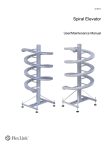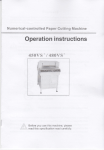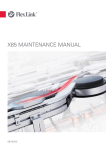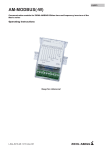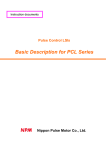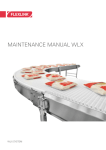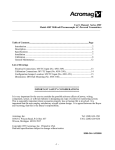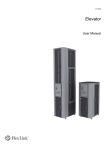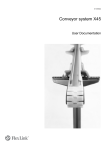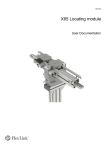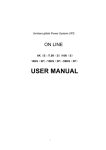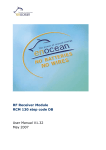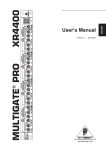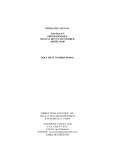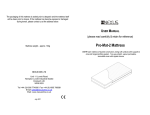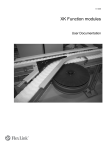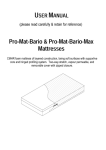Download Spiral Elevator - Automatic Feeder Company Inc.
Transcript
Created by EBCCW 00:06 96:05 Created by EBCCW 00:06 5478EN-3 Spiral Elevator Type 5995512 User Manual Original Instructions 2011 Created by EBCCW 00:06 96:05 Created by EBCCW 00:06 Spiral Elevator User Manual © Flexlink Components AB 2010 All Rights Reserved No part of this program and manual may be used, reproduced, stored or transmitted in any form or by any means without the written permission of FlexLink Components AB. The contents of this manual are for informational use only. All information and specifications contained in this document have been carefully checked to the best efforts of FlexLink Components AB, and are believed to be true and accurate as of time of publishing. However, due to continued efforts in product development FlexLink Components AB reserves the right to modify products and its manuals without notice. FlexLink Components AB assumes no responsibility or liability on any errors or inaccuracies in this program or documentation. Any kind of material damages or other indirect consequences resulting from any FlexLink Components AB product part, documentation discrepancies and errors or non-anticipated program behavior are limited to the value of appropriate products purchased from FlexLink Components AB. The products are delivered to the customer at the ’as is’ state and revision level they are on the moment of purchasing, and are declared in detail in the license agreements between FlexLink Components AB and user. User accepts and is obliged to follow the guidelines stated in the separate license agreement needed in using any parts of this product package. 5478EN-3 5478EN-3 Created by EBCCW 00:06 Content 1 Safety ....................................................... 3 5.2 Assembly ................................................29 1.1 System information.................................. 3 5.3 Validation ................................................33 1.2 The most important safety conditions ...... 4 5.4 Integration in a (transport) system .........35 1.3 Description of safety provisions ............... 5 5.5 Setting of the Spiral Elevator...................37 1.4 Safety measures to be taken .................... 6 5.6 Test run - partially loaded........................39 1.5 Explanation of symbols ............................ 7 6 Technical maintenance ............................43 2 Technical specifications............................ 8 6.1 Check and control procedures ................43 2.1 Technical data........................................... 9 6.2 Maintenance procedures.........................47 2.2 Ordering information.............................. 10 6.3 Troubleshooting list ................................57 2.3 Operating conditions .............................. 11 6.4 Maintenance schedule Spiral Elevator.....60 3 Introduction ........................................... 12 7 Put out of commission............................62 3.1 Purpose of use ....................................... 12 7.1 Disconnect the power sources ................62 3.2 Description of the Spiral Elevator ........... 13 7.2 Disassemble............................................62 3.3 Working principle ................................... 19 7.3 Transport ................................................63 3.4 Control units .......................................... 21 7.4 Disposal ..................................................64 4 Unload the Spiral Elevator ...................... 22 7.5 Reuse......................................................64 4.1 Preparation............................................. 22 8 Spare parts list........................................65 4.2 Unloading instructions ........................... 23 8.1 Spiral Elevator 5995512..........................65 5 Mounting, installation, adjustment ......... 27 9 Supplier’s information.............................66 5.1 Provisions to be provided ...................... 27 10 Manufacturer’s declaration......................67 5478EN-3 Page I of II Page II of II 5478EN-3 Preface Purpose of this manual The purpose of this manual is to describe various operations that are intended for the user to perform. This document contains remarks that point out a risky or specific situation to the user. In many cases this situation is provided with one of the symbols given below. General warning for danger! . Warning for electrical voltage! . Attention, this is an important notice! . Compliance with the operations described in this document is important in order to prevent dangerous situations and unnecessary damage to the Spiral Elevator It is recommended to keep one copy of this manual near the machine and one copy with your technical documentation. Structure of the manual Created by EBCCW 00:06 The user's manual has been composed in such a way, that a number of operations can quickly and easily be found. This manual does not describe operations that are not intended for the user to perform. The user's manual has been divided into sections which describe a variety of functions including the safety and the safe operation of the Spiral Elevator. It is recommended that this manual is read by all users of this equipment with particular reference to Section 1 on page 3: Safety. 5478EN-3 Page 1 of 68 Requirements of the user The Spiral Elevator should only be operated by a person who has become acquainted with section 1 'safety' and trained in the use of the unit. The Spiral Elevator should only be installed by persons who have become acquainted with section 4 'unload the Spiral Elevator. . . Note! Maintenance activities on the Spiral Elevator should only be carried out by a technically qualified person. Note! Technically qualified employees means: persons that have received adequate training for carrying out the activities involved. Page 2 of 68 5478EN-3 Safety 1 Safety The Spiral Elevator has been designed such, that it can be used and maintained in a safe way. This holds for the application, the circumstances and the instructions described in the manual. Any person working with or on this machine should study and follow the instructions contained within this manual. The company or the country in which the machine is used may require extra safety measures. This particularly applies to the working conditions. This manual does not describe how these are to be complied with. In case of doubt, consult your government or safety officer! 1.1 System information The project number and/or general drawing number (identification number) shall always be specified when communicating with FlexLink with respect to the Spiral Elevator. The following detail plates are generally attached to the Spiral Elevator. Created by EBCCW 00:06 Figure 1 Example of Machine plate (system supplier) Figure 2 Spiral Elevator plate ( Manufacturer) 5478EN-3 Page 3 of 68 Safety 1.2 The most important safety conditions Before the Spiral Elevator is put in to service, the following safety conditions must be met: • Provide good ambient lighting. • Equipment users should have read and understood the operating instructions to operate, maintain or clean the machine. • Equipment users should not reach into the machine while it is running. Even if the machine is not running, it may be 'on', which means it may start operating automatically. • Safety provisions (where fitted), such as side plating, bottom plating, emergency stops and detectors must not be removed or deactivated while the Spiral Elevator is running. • Before clearing of any jams, the unit should be stopped and safely isolated. Page 4 of 68 5478EN-3 Safety 1.3 Description of safety provisions As a standard the Spiral Elevator is not provided with control or any safety provisions. Before putting the Spiral Elevator into service some safety provisions are to be incorporated. The purpose of these safety provisions is to protect the user, the product and the Spiral Elevator against undesired situations (damage). If these safety provisions are not incorporated it will invalidate the warranty. The table below gives a general description of the safety provisions required. Only technically qualified persons should work on the settings of the safety provisions! The safety provisions listed in the table are a general guide only. The actual safety provisions to be used must be determined by relevant risk assessment of the overall system. Control Remark Emergency stop switch Each Spiral Elevator is to be provided with one or more emergency stop switches that can be operated within reach of the user. The emergency stop switch must make sure that the input and output conveyors or machines are switched off simultaneously. Motor protection The technical specification of the Spiral Elevator is, among other things, geared to the load given in the technical specification, quotation or drawing. Should the Spiral Elevator (gear motor) become overloaded, this should be detected by the motor protection in the control system. Without this protection there is a chance that the gear motor or other components of the Spiral Elevator will be damaged and this damage will not be covered by the warranty. Motor isolation Means of isolating the motor from the power supply must be provided and within close proximity to the motor. Where the possibility exists for oversize product to enter the Spiral Elevator it is recommended to install a detector prior to the Spiral Elevator and use this to stop the elevator thus preventing damage from occurring. Created by EBCCW 00:06 Note! If an oversize product jams in the Spiral Elevator it may damage the unit. 5478EN-3 Page 5 of 68 Safety Mechanical Remark Height / width detector Product entering the Spiral Elevator should not be of a size where the product can become jammed in the Spiral Elevator. In order to ensure that product cannot become jammed in the Spiral Elevator due to oversize some automatic checks for width and height can be done. This detection must take place before the Spiral Elevator in order to stop the product or Spiral Elevator. The maximum dimensions of the product are given in the technical specification, quotation or drawing. Transition guard The basic Spiral Elevator is not supplied with any guarding at the drive / idler ends. A risk assessment should be conducted with consideration to the adjacent conveyors/equipment product etc. to establish any requirements for guarding. Note! Only technically qualified persons are allowed to change the settings of the safety provisions. . 1.4 Safety measures to be taken For a safe operation of the Spiral Elevator a number of safety measures are to be taken. These include the following measures: • Clean floor surface - With a clean floor surface the operator will not be hindered while operating the Spiral Elevator. This can prevent tripping or slipping, so that the operator does not unexpectedly come into contact with the Spiral Elevator. • Hearing protection -Different tests have shown that the Spiral Elevator does not produce more than 85dB(A) Page 6 of 68 5478EN-3 Safety 1.5 Explanation of symbols Pictogram symbols have been placed on the Spiral Elevator in order to identify to the user certain conditions or provide certain information on components of the Spiral Elevator. No. Description Picture 1.Spiral Elevator plate This contains the name and the address of the initial manufacturer, series or type indication, serial number and the year of construction of the Spiral Elevator. 2.Gear motor plate This contains information of the gear motor supplier along with the CE-mark if appropriate. Also indicated is the gear motor type, applicable voltages, power, oil type etc. Example of Gear motor plate 3. Machine plate This contains the system supplier, installation date and the Identification Number of the Spiral Elevator and information of the system supplier along with the CE-mark if appropriate. Created by EBCCW 00:06 Example of Machine plate 5478EN-3 Page 7 of 68 Technical specifications 2 Technical specifications Below is the technical specification of the Spiral Elevator. Further product details to which the Spiral Elevator has been designed are contained within the overall Project Documentation (when purchased as part of a Project System). Use of the Spiral Elevator outside of the scope detailed within the technical specification, quotation or documentation will invalidate the warranty. General FlexLink Spiral Elevator specification • 500 mm inclination per winding (9 degree) • 3-8 windings • 1000 mm nominal centreline diameter • Speed 5 - 60 metres per minute • Lower height:- 600, 700, 800, 900 or 1000 mm - Adjustable -50/+70 mm • Max load 10 Kg/m (specific Spiral Elevators may be with a lower limit due to actual gear motor used) • Product size: - width= 50 - 200 mm - length= 80 - 250 mm - height= 1,5 x Length (max 300 mm) - see Project Documentation if applicable • Drive and idler ends are horizontal • Chain width 100 mm • Friction top chain • Steel chain with bearings running on the inner guide rail • Wet coated mild steel frame • Column diameter 160 mm • M8 thread for guide rail Page 8 of 68 5478EN-3 Technical specifications 2.1 Technical data 500 mm (inclination) 5000 mm (Max. heigth 8 windings) Lower height 600/700/800/900/1000 mm -50/+70 Machine incl. adjustable feet 5° 8x45° 350 815 In/ Out Feed Configurations n159 985 Created by EBCCW 00:06 1000 5478EN-3 Page 9 of 68 A B Technical specifications 2.2 Ordering information Example of a Spiral Elevator designation obtained from the FlexLink product configurator: Item no A B C D E F G H I 5995512 100 - 1000 - 500 - S - A -TU - 800 - 3 - 25 5995512- Item number A Chain width B Spiral center of chain diameter C Incline per winding D Mild steel (S) material configuration E Configuration A or B F Transport direction up/down TU or TD G Lower height 600/700/800/900/1000 H Number of windings 3,4,5,6,7,8 I Shaft diameter 20 mm (for gear motor type SA37) or 25 mm (for gear motor type SA47) For more information please contact your local FlexLink office. Page 10 of 68 5478EN-3 Technical specifications 2.3 Operating conditions The circumstances under which the Spiral Elevator can be operated partly depend on the materials selected. FlexLink has defined a number of parameters within which the Spiral Elevator would be allowed to function. Should the Spiral Elevator still be operated beyond these limiting values, FlexLink cannot guarantee the good functioning of the Spiral Elevator. Ambient temperature (in operation) 0 to +35°C During transport / storage 5 to +40°C Relative air humidity (RH) 30% to 95%, not condensing Lighting Normal ambient lighting Height Up to max. 2000 m above sea level As a standard no lighting is installed on the Spiral Elevator although this can not be added as an option. Normal ambient lighting is sufficient to work safely with the Spiral Elevator. The Spiral Elevator is not intended for use in an open air environment or in an area with a risk of explosion, although static safe materials are available. Created by EBCCW 00:06 If in doubt of the suitability FlexLink should be consulted. 5478EN-3 Page 11 of 68 Introduction 3 Introduction This section deals with a number of general matters with respect to the Spiral Elevator. This involves, among other things, the purpose of use, the conditions of use and the working principle of the Spiral Elevator. Should you have any further questions on the safe operation of the Spiral Elevator please contact FlexLink. The warranty conditions have been included in the FlexLink quotation or are available separately from FlexLink. FlexLink does not accept any liability for unsafe situations, accidents and damages resulting from: • Neglect of warnings or stipulations as displayed on the machine, in this documentation or in the Project Documentation (if applicable). • Use in applications or circumstances other than those specified in this manual, the quotation, the Project documentation (if applicable), or FlexLink catalogue. • Modifications to the machine. This also includes the use of replacement parts other than those specified and supplied by FlexLink. • Insufficient or incorrect maintenance. FlexLink does not accept any liability for the consequential damage in case of failures of the machine, for example damage of products, interruption of operation, etc. 3.1 Purpose of use The purpose of use of the Spiral Elevator is to transport products / goods in a vertical direction. This may be for bridging a difference in height or for functioning as a cooling buffer. It is not recommended to use the Spiral Elevator for transporting products with parts that are protruding, hanging loose, for transporting products that result in a higher load than mentioned in the documentation or for transporting products with measurements deviating from those given in the technical specification associated with the particular Spiral Elevator. Additionally it is not permitted to walk, stand or sit on the Spiral Elevator or to stick objects or body parts between the guards, conveyor plates or other moving parts. Page 12 of 68 5478EN-3 Introduction 3.2 Description of the Spiral Elevator The Spiral Elevator is applied in a (transport) system where products can be transported vertically in a relatively small area. The Spiral Elevator can be coupled to other transport systems and be built according to the customer's needs. A B Figure 3 Principle sketch (Transport direction up) / Configuration options Created by EBCCW 00:06 Before the Spiral Elevator is put in to service a suitable Risk Assessment should be completed. After integration / installation the Spiral Elevator should not be relocated without further Risk Assessment 5478EN-3 Page 13 of 68 Introduction Configuration input / output The configuration of the Spiral Elevator is available in different formats with regard to input / output positions. These configuration types are expressed in the letters A or B. A B It is possible to have a configuration with which the output side is placed at a different angle. For any special configurations please contact FlexLink. Dimensions of the Spiral Elevator The height of the Spiral Elevator is dependant upon the low level height plus the number of turns of the spiral (see Technical Specification - Section 2 on page 8). Page 14 of 68 5478EN-3 Introduction Components Spiral Elevator The Spiral Elevator consists of the following components: 1 2 3 4 5 Created by EBCCW 00:06 Figure 4 Components Spiral elevator 5478EN-3 Page 15 of 68 Introduction No. Component Description 1, 2, 4 and 5 Frame The basic frame of the Spiral Elevator consists of a central column (1), an upper end (2), a lower end (5) and a frame (4) that is attached to the floor surface. The materials of these components depend on the configuration selected. Both the upper end and the lower end may function as the input or output part of the Spiral Elevator. 3. Conveyor chain (slats) The conveyor chain consists of a chain and conveyor chain / plates with guide rollers. The top of the chain has a high friction material to ensure no sliding of products on the chain. The conveyor chain rotates in a spiral form around the central cylinder and is guided on the plastic slide strips. The conveyor chain is driven by the gear motor. Gear motor The gear motor is mounted on the drive shaft of the conveyor drive end. The standard Spiral elevator is not delivered with a gear motor. However a gear motor may be added as part of the supply contract. Suggested Gear motor specifications can be obtained from the FlexLink Configurator or from FlexLink. The gear motor requires a Torque arm kit and a Absorber kit to prevent rotation and two types are available as follows: • For SA37 type gear motors, Torque arm kit = 5057039 - • Absorber kit = 5113736 For SA47 type gear motors Torque arm kit = 5050459 - Absorber kit = 5113736 On the driving shaft a sprocket wheel has been mounted that is connected to the chain of the conveyor chain. Guide rail, optional The guide rail ensures that the products follow the conveyor chain and prevent them from falling off the Spiral Elevator. Spiral elevator (typically as delivered) Lower end Page 16 of 68 Upper end 5478EN-3 Introduction General terminology used for the Spiral Elevator parts Central column A B Lower end unit B 6 Upper end unit 1 2 3 4 5 7 8 6 1 Metal chain or transmission chain 2 3 7 Slide rail 4 Sprocket or Sprocket wheel Base frame Created by EBCCW 00:06 Feet 5478EN-3 Bearing for conveyor chain Link Conveyor A 8 Conveyor chain plate, link or slat Page 17 of 68 5 Sprocket or Sprocket wheel Bearing housing with bearing Introduction 4 3 1 2 1) Conveyor plate 1) Motor 2) Basic chain 2) Drive shaft 3) Link 3) Sprocket wheel 4) Bearing 4) Torque arm Components conveyor chain No. Component Description 1. Conveyor chain plate (slat) Narrow plastic plate provided with a guide roller. Conveyor plates are mounted in a row on the basic chain and so form the transport surface. 2. Metal chain (transmission chain) This is a laterally flexible chain on which the conveyor chain is mounted. 3. Link Links of the Metal chain (item 2) 4. Bearing Bearing for the conveyor chain plate Components conveyor drive end and gear motor No. Components Description 1. Gear motor Optional 2. Drive shaft _ 3. Sprocket wheel _ 4. Toque arm Type specific dependant upon gear motor type Page 18 of 68 5478EN-3 Introduction 3.3 Working principle The purpose of the Spiral Elevator is to transport products / goods vertically to bridge a difference of height. 2 1 5 3 4 Created by EBCCW 00:06 Figure 5 Principle sketch Spiral elevator 5478EN-3 1 Conveyor chain 2 Upper end 3 Lower end 4 Return part 5 Gear motor (not shown) Page 19 of 68 Introduction In most cases the Spiral Elevator is integrated in to a system. The input / output side of the Spiral Elevator is determined dependent on the system. In the following example, it is assumed that the input is at the lower end of the Spiral Elevator and that the product will bridge a difference in height in order to continue the required transport on the output. Input end Transport of Products Output end 1 The product is transferred onto the input of the Spiral Elevator. The gear motor drives the conveyor chain with the required speed. 2 Subsequently, the product on the conveyor chain will travel around the Spiral Elevator and bridge the height difference between input and output. 3 When the product arrives at the output of the Spiral Elevator it will continue along the system. The conveyor chain returns in the underside of the Spiral Elevator to the input position. Page 20 of 68 5478EN-3 Introduction 3.4 Control units As a standard the Spiral Elevator is delivered without any control system. When a Spiral Elevator is supplied without control it is the responsibility of the system integrator / installer to design a suitable control system. It is preferable to install an isolating switch for the gear motor and it should be of a type able to be padlock off.With this switch the power to the gear motor can be switched / locked off in order to ensure safe working on the Spiral Elevator. The designer of the Control System should evaluate the requirements of other devices such as Emergency stops etc. in order to provide a safe working system. Created by EBCCW 00:06 Figure 6 Example of a Isolator 5478EN-3 Page 21 of 68 Unload the Spiral Elevator 4 Unload the Spiral Elevator 4.1 Preparation Before starting the unloading, good preparation is required. The appropriate devices must be available. A series of checks must be made to the Spiral Elevator and these should be done: • Before off-loading from the delivery vehicle. • Immediately after off-loading. • Immediately after unpacking. Any damage must be detailed on the delivery note before signing for acceptance of delivery and also notified to FlexLink in order to possibly progress any warranty claim. Details of the dimensions and technical specifications are available on one or more of the following: • Technical specification • Quotation • Drawing • Order Any deviation must be notified to FlexLink immediately. Page 22 of 68 5478EN-3 Unload the Spiral Elevator 4.2 Unloading instructions Initially the Spiral Elevator should be removed from the delivery vehicle by lifting the Spiral Elevator complete with any pallet base and / or packing materials. Before starting unloading, all fastening means (securing belts, screws, etc.) that secure the Spiral Elevator onto the transport vehicle must be removed. It is preferable to move the Spiral Elevator complete with any pallet base and / or packing materials to an area near to the final position and then unload the spiral elevator and place it directly on the floor whilst taking care not to cause any damage to the painted surfaces. The Spiral Elevator may be delivered horizontally or vertically dependent on the dimensions. If the Spiral Elevator is delivered vertically it can be lifted using a ForkLift truck under the base frame or by using a sling and suitable eye bolt in the top of the central column. Created by EBCCW 00:06 If the Spiral Elevator is delivered horizontally, it can be lifted using a ForkLift truck with forks spaced wide apart and inserted under the horizontal central column. Soft packing should be used between the forks and the central column to avoid damage and marking. Care must be taken to avoid the Spiral Elevator rolling whilst on the forks. Alternatively slings can be used and attached to two positions around the central column. 5478EN-3 Page 23 of 68 Unload the Spiral Elevator 4.2.1 Erecting the Spiral Elevator This section is for taller Spiral Elevators which are transported in the horizontal position. When putting the unit upright or when moving the Spiral Elevator make sure that the floor is level and clean and has sufficient load carrying capacity. It is generally safer to move the Spiral Elevator to a position close to the final area with the Spiral Elevator remaining on the delivery packing (where applicable). When the Spiral Elevator is near to the final position it can be put upright. Dependent on the situation, the Spiral Elevator can be raised to upright using a hoist, a crane or a forklift truck. Device(s) Hoist Crane . Open-end spanner Note! Make sure when raising to upright, that there is enough space / height to put the Spiral Elevator upright. Page 24 of 68 5478EN-3 Unload the Spiral Elevator The following describes a typical method utilizing a hoist • The hoisting device is to be fastened to the cylinder at the top of the Spiral Elevator. Whilst hoisting, the hoist should be well fixed and must not be able to ride/shift away unexpectedly. • Raise the top of the Spiral Elevator around 200mm and stop. • Remove the frame with feet which is temporarily mounted to the Spiral Elevator column top. • Raise the Spiral Elevator until lifted completely from the floor and in the vertical position. Take care not to put excessive side load on the feet to avoid bending or damaging them Note! Be aware that the Spiral Elevator may tip at the moment it is near to the upright position. Make sure there are no persons near the Spiral Elevator! . Created by EBCCW 00:06 • 5478EN-3 Remove feet from the now horizontal position and re-fit in to the other holes in the frame to have the feet in the vertical position. Page 25 of 68 Unload the Spiral Elevator . . . • Re-attach the frame with feet, to the final position at the bottom of the Spiral Elevator column. Attach the stay brackets between the Spiral Elevator column and the bottom frames. • Remove feet from the now horizontal position and re-fit in to the other holes in the frame to have the feet in the vertical position. • Check all bolts for the lower frames, feet and stay brackets are in place and secure. • Lower the Spiral Elevator down on to the floor. • Move the Spiral Elevator in to final position taking care not to place undue side load on the feet to avoid damage. If the Spiral Elevator is moved using a ForkLift truck or Pallet Truck, great care must be taken due to the height of the Spiral Elevator to ensure that it does not topple over. • The feet can be adjusted to give the correct height. Make sure all four feet are adjusted evenly. Note! Carry out these operations calmly in order to be able to carefully monitor any movement of the Spiral Elevator. Warning: It is forbidden to walk under the Spiral Elevator duringthe procedure of rising to the upright position. Note! Make sure that while raising the Spiral Elevator that there are no unauthorised persons near the Spiral Elevator. Page 26 of 68 5478EN-3 Mounting, installation, adjustment 5 Mounting, installation, adjustment This section deals with the installation and adjustments for the Spiral Elevator. The safety conditions detailed in section 1.2 and the Safety Provisions detailed in section 1.3 should be read and understood before installation. 5.1 Provisions to be provided Make sure before integrating that the safety measures detailed in section 1.4 are taken. 5.1.1 Floor construction During installation / integration a number of items must be considered including the suitability of the floor and how the unit is fixed to the floor. Created by EBCCW 00:06 Tools (typical) 5478EN-3 • After having placed the Spiral Elevator in the correct position, the Spiral Elevator should be set to the correct height and the column must be vertical. • Following this the feet should be fastened to the floor surface by using the holes in the adjusting feet. • Fasteners suitable for the type of floor / mounting surface should be used. Page 27 of 68 Mounting, installation, adjustment 5.1.2 Links to adjacent conveyor systems Any additional bracing of the Spiral Elevator in-feed should be provided where necessary. Any additional bracing of the conveyor/process after the Spiral Elevator out-feed should be provided where necessary. With the correct heights set, the distances between the Spiral Elevator ends and the adjacent conveyors / machines can be set. The gap between spiral conveyor end and adjacent conveyor / machine should not be greater than 25mm and depends upon various factors such as product being transferred and safety considerations. A sliding bridge or roller bridge may be needed for transfer of products. Figure 7 Example of typical connection to an adjoining conveyor If conveyors are to be attached to the Spiral Elevator it is possible to use the specially designed joining pieces which are available from FlexLink. Page 28 of 68 5478EN-3 Mounting, installation, adjustment 5.2 Assembly This paragraph describes a number of operations for Spiral Elevators that are not delivered fully assembled. After having finished mounting the Spiral Elevator, the Spiral Elevator can be integrated (Section 1.4) in a system. 5.2.1 Motor The gear motor may be delivered separately with the Spiral Elevator and then has to be mounted on site. First check if all the required parts are present: • Gear motor • Grease • Torque arm • Key for shaft • Fasteners (screw and washer) The key and torque arm fastening to the frame may be pre-assembled. The required tools are: Open-end spanner Ring spanner Internal spring pliers Created by EBCCW 00:06 Procedure: 5478EN-3 • Determine the installation orientation of the gear motor. • Apply installation grease on the shaft to slide the gear motor onto the shaft easier and prevent any fretting corrosion. • Attach the torque arm to the gear motor with the appropriate fixings. • Place the locking ring (circlip) in the gear motor or move to the desired groove in gear motor (if not already in the correct position). Page 29 of 68 Mounting, installation, adjustment (Note: The conveyor and gear motor shown are not necessarily the same type as supplied.) • In the correct orientation, slide the gear motor on the shaft up till the locking ring (aligning the keyway to key). • Attach the torque arm to the Spiral Elevator drive end. • Fasten the shaft to the motor with bolt and washer inside the gear motor hollow shaft and place the cover to protect the opening (if cover is applicable). • Check all fastenings and remove excess installation grease. Page 30 of 68 5478EN-3 Mounting, installation, adjustment 5.2.2 Mounting Guide rail components The basic Spiral Elevator does not include guide rail or brackets. Along the sides of the conveyor track are M8 tapped holes typically every 45º to allow brackets to be attached. The following describes how a typical FlexLink Guide Rail Bracket system can be used on the Spiral Elevator. For final detail of the optimum guide rail and bracket arrangement consult the Spiral Elevator supplier or FlexLink. Tools Typical Guide Rail and bracket components 4 5 3 2 6 1 Note! Created by EBCCW 00:06 Guide rail components (typical) 1 Guide rail bracket 2 Guide rail clamp support 3 Guide rail clamp 4 Guide rail 5 Guide rail cover 6 Distance piece Note! Grind or cut off the small lugs on the FlexLink guide rail bracket (or distance piece) before assembly. 5478EN-3 Page 31 of 68 Mounting, installation, adjustment Procedure for fitting a typical guide rail Attach the Guide Rail Brackets to the frame. If an offset has been chosen, any distance piece has to be placed between the frame and the Guide Rail Bracket. The bolts used to attach the brackets to the conveyor sides should be M8. The length of bolt depends upon the guide rail bracket arrangement used, but should not protrude in to the beam profile by more than 10mm. With the brackets in place, the guide rail profile can be mounted to the brackets and clamps. Figure 8 Connection mounting bracket If the guide rail is to be FlexLink polyethylene, XLRS 3x15 P type then to ensure rigidity at the ends it is suggested to pre-bend a 150 mm long and 10x10 mm metal bar or an Ø10 mm metal rod to the radius of the guide rail and insert it in the guide rail at each end. Make sure that there is a smooth connection between the guide rail joints, to ensure product passes along the guide rail un-hindered. Page 32 of 68 5478EN-3 Mounting, installation, adjustment 5.3 Validation Initially the validation checks should be for visual condition and dimensions. Subsequently a short test run should be made with the Spiral Elevator in an un-loaded condition. 5.3.1 Dimension check Spiral Elevator The technical specification and / or relevant drawing can be used for the dimension check. 5.3.2 Adjusting and setting the Spiral Elevator Before the start of the test run make visual checks for jammed parts or items touching the Spiral Elevator chain links and stop immediately if any exist. During the test run pay attention to the correct rotation direction of the conveyor chain and look at the behaviour of the conveyor chain and the operation of the drive. The chain should move evenly and without undue jerking motions. It is not recommended to make a test run with the machine while the safety provisions have been deactivated or guards removed. Make sure that the operation is as safe as possible and that there are no unauthorised persons near the Spiral Elevator. If during the test run abnormal sounds are heard or if there is an impression that other irregularities occur, immediately switch off the Spiral Elevator then investigate and remedy the cause. The checklist in section 5.6 and the troubleshooting list in section 6.3 may be of assistance. If the problem cannot be solved, please contact the supplier for advice before continuing the integration. Created by EBCCW 00:06 If the initial test above is OK, then the following test procedure may be followed. 5478EN-3 Page 33 of 68 Mounting, installation, adjustment Test Procedure No. Test Checks Duration 1. Run the Spiral Elevator for very short duration (at 10 Hz if variable speed motor). Check the Spiral Elevator for the rotation direction of the conveyor chain. If this is not correct, then make necessary adjustments to the electrical control circuit or system. 2. Run the Spiral Elevator (run at 10 Hz if variable speed motor). Check whether the conveyor chain plates have been mounted correctly the conveyor chain and the plates run evenly over the slide rail. Carried out Yes / No 10 minutes Yes / No Check whether the chain runs smoothly and without any significant noises. Should there be any problems, refer to the troubleshooting list in Section 6.3. 3. Run the Spiral Elevator at 25 Hz (if variable speed motor). Repeat the checks in item 2 above. 10 minutes Yes / No 4. Let the Spiral Elevator run at the nominal speed described in the technical specification or detailed within the quotation. Check for peculiar sounds or unusual movements of components. 10 minutes Yes / No 5. . Check whether the chain runs smoothly and without any significant noises. Should there be any problems, refer to the troubleshooting list in Section 6.3. If all of the items above have been complete and the Spiral Elevator runs satisfactorily, then the remaining parts of the overall system can be checked and the overall subsequently run. Yes / No Warning: It is not recommended to make a test run with the machine while safety provisions have been deactivated or guards removed. Page 34 of 68 5478EN-3 Mounting, installation, adjustment 5.4 Integration in a (transport) system The Spiral Elevator is a machine that is integrated in a system of conveyors. This means that an input and output are to be connected to it. If the Spiral Elevator is to be fitted into an existing situation, this usually gives more problems with the installation than in a completely new situation. 5.4.1 Frequency control The operating conditions are optimal when the speed of the Spiral Elevator is equal to the speeds of the in-feed and out-feed conveyors or machines. If a speed difference does exist this can lead to product twisting at the transfers and wear of the high friction conveyor plates. If there are speed differences which are unavoidable, these should be kept bellow 15% and the preferred arrangement is as follows: • Spiral Elevator up to 15% faster than in-feed conveyor or machine speed. • Out-feed conveyor or machine speed to be up to 15% faster than Spiral Elevator. The speeds can be tuned by using a frequency controller within the control system if desired. If a frequency controller is used for the speed control, ramp-up and rampdown settings should be set such that the Spiral Elevator chain does not 'snatch' or 'jerk' on starting or stopping. Created by EBCCW 00:06 . 5478EN-3 Note! For the correct setting of the frequency controller the technical specification supplied with the unit should be followed. Page 35 of 68 Mounting, installation, adjustment 5.4.2 Checklist integration After the integration the checklist given below should be completed to ensure a satisfactory integration. No. Component Remark Checked 1. Lower end Is the lower end at the correct height and is the distance to the adjacent conveyor / machine satisfactory (should be below 25mm and suitable for other considerations regarding product transfer and safety)? Yes / No For correct height refer to technical specification, quotation details or drawings. 2. Upper end Is the upper end at the correct height and is the distance to the adjacent conveyor / machine satisfactory (should be below 25mm and suitable for other considerations regarding product transfer and safety)? Yes / No For correct height refer to technical specification, quotation details or drawings. 3. Spiral Elevator Is there sufficient space around the Spiral Elevator to allow adequate access for operation, and maintenance? Yes / No 4. Fastening / foundation Is the Spiral Elevator fixed to the floor satisfactorily and is the central column vertical? Yes / No Page 36 of 68 5478EN-3 Mounting, installation, adjustment 5.5 Setting of the Spiral Elevator The mechanical and control setting for the Spiral Elevator need to be done correctly, with particular regard to the ends and transfers to ensure good operation. 5.5.1 Mechanical Mechanically there are a number of items which can be set for the Spiral Elevator. The general items are detailed below . Tools No. Component Setting / Remark 1. Height setting Spiral Elevator The adjusting feet can be used to set the Spiral Elevator to the correct height. If necessary, the connecting conveyors should be adjusted to this as well. It is not possible to change the difference in height between the lower and upper ends after the Spiral Elevator has been manufactured (i.e. the pitch between turns are fixed). 2. Guide rail, input and output (optional) The guide rail width setting may be able to be adjusted at infeed and outfeed ends of the Spiral Elevator in order to align with the feeding and receiving conveyor systems. This may depend upon which guide rail and brackets are fitted. Created by EBCCW 00:06 It may be possible to 'flare out' the guide rails at the in-feed end of the Spiral Elevator 5478EN-3 Page 37 of 68 Mounting, installation, adjustment 5.5.2 Controls The table below gives some general guidelines with regard to the control system used to operate the Spiral Elevator. . No. Component Setting Remark 1. Frequency control (where fitted) 15% The speed difference of the feeding conveyor to the Spiral Elevator or the Spiral Elevator to the receiving conveyor should generally be below the setting value. This is to avoid product twisting at the transfers and excessive slipping of the product on the conveyor or Spiral Elevator chain. 2. Emergency stop switch Direct The Spiral Elevator should be protected via an emergency stop circuit, such that if the relevant emergency stop button (or other) is activated, all power is removed from the Spiral Elevator gear motor, following which the Spiral Elevator may overrun a little (depending upon speed). The full details of the emergency stop circuit and procedure must be evaluated by the persons responsible for designing the control system. 3.a. Start / Stop via 'Direct on Line' control <3 sec. The conveyor will start almost immediately and will stop and overrun a little (depending upon speed). 3.b. Start / Stop via Frequency controller (Inverter) 2 sec. For normal conditions the ramp-up and ramp-down time set in the frequency controller should be set to 2 seconds. 4. Height / width detector Direct Where over height or over width detection is incorporated, the stopping of the conveyor should be activated immediately with the stopping times suggested in the above items. Page 38 of 68 5478EN-3 Mounting, installation, adjustment 5.6 Test run - partially loaded In this paragraph the Spiral Elevator will be checked in a semi-loaded condition with all safety provisions activated. If during the test run any of the following situations occur, the test must be stopped and the Spiral Elevator must not be tested further until the issue has been solved. • Irregular sounds • Other irregularities / anomalies • Spiral Elevator does not meet specifications • Some of the product do not fit on the Spiral Elevator • Product become stuck or slip Carry out the check Initially start the Spiral Elevator with no product loaded and conduct the items in the checklist. Then gradually add product to the system up to 50% of the specified feed rate as detailed in the technical specification or quotations and conduct the items in the checklist again. The gradually add more product to the system up to 100% of the specified feed rate as detailed in the technical specification or quotations and conduct the items in the checklist again. If during any of the tests problems are detected, the Spiral Elevator must be stopped and the problem investigated / remedied and then the tests restarted. Check Spiral Elevator Below is the checklist detailing the main items to check on the Spiral Elevator when making the test runs. Created by EBCCW 00:06 Checklist No. Check Remarks Passed 1. Does excessive noise occur? This may occur because the tension of the chain is not correct, conveyor plates are loose or a sprocket wheel is not aligned (see Section 6.3 on page 57). Yes / No 2. Is a 'ticking' sound is present? This may occur because the tension of the chain is not correct, conveyor plates are loose or a sprocket wheel is not aligned (see Section 6.3 on page 57). Yes / No 5478EN-3 Page 39 of 68 Mounting, installation, adjustment No. Check Remarks Passed 3. Are any conveyor chain plates moving unexpectedly at any position throughout the Spiral Elevator? This may occur if there are some loose conveyor plates (see Section 6.3 on page 57). Yes / No 4. Are there any conveyor chain plates which are raised at any position? This may occur because conveyor plates are loose or the reversing rollers or a sprocket wheel are not aligned well (see Section 6.3 on page 57). Yes / No 5. Are there any damaged conveyor chain plates or is there friction material missing? If any are detected the conveyor chain plates concerned are to be replaced (see Section 6.2.2 on page 48). Yes / No 6. Are conveyor chain plates touching the frame, the guide, the guard or anything else? Adjust the guide or the guard and carefully check the correct setting / dimension of this. See 'technical specification', quotation or drawing for any relevant settings. Yes / No 7. Do all products fit on the conveyor chain? Check in the technical specification, quotation or drawing whether the product dimensions are correct to those specified. Yes / No 8. Do any products slide off of the conveyor chain? Are the conditions, sizes and weights of the products correct to the technical specification, quotation or drawing? Yes / No Is there any 'foreign substance' on the product or conveyor chain reducing the effect of the friction material? Generally the sliding of products should not occur, therefore contact the supplier. 9. 10. Are there any products that do not continue over the transfer on to or off of the Spiral Elevator. Check the condition of the transfers. Is the product arriving on to and transferring off of the Spiral Elevator correctly oriented? The design of the adjoining equipment should be checked. Yes / No Any transfers supplied as part of the system are in addition to the standard Spiral Elevator and generally these transfers are not powered, therefore some product may remain on the transfer (depending upon various factors such as speeds, condition, size or weight of product). Page 40 of 68 Yes / No 5478EN-3 Created by EBCCW 00:06 Mounting, installation, adjustment No. Check Remarks Passed 11. Is the product properly transported throughout the Spiral Elevator. Generally the product will not twist whilst travelling up or down the Spiral Elevator. If undue twisting does occur, discuss this with the supplier. Yes / No 12. Are there any protrusions or irregularities along the guide rail? The product should not stick or jam against the guide rail. Yes / No 5478EN-3 Page 41 of 68 Mounting, installation, adjustment Check (safety) provisions The basic Spiral Elevator supplied by FlexLink does not include any additional safety provisions such as isolators, stop/start devices, emergency stopping systems or guards at the in-feed / out-feed ends. Any issues with regard to the safety items should be investigated and discussed with the designer of the control and safety system. Below is a check list for some general safety items. No. Check Remarks Passed 1. Does the stop button stop the Spiral Elevator within the time expected. Both the Spiral Elevator and the input/output chain should stop immediately within the time dictated in the 'technical specification', control design specification or within 3 seconds depending upon speed. Yes / No 2. Does the Spiral Elevator stop when the emergency stop is pressed. The Spiral Elevator should stop immediately and this should be less than 3 seconds depending upon speed. Yes / No 3. Does the optional height / width indicator function when processing a product which is too large. The height / width detector should react when a product is coming by that is larger than the specified product mentioned in the 'technical specification' or quotation. Yes / No Should the (safety) provisions not function as expected, they should be set or adjusted again or repaired by the person responsible (installer / technician). Page 42 of 68 5478EN-3 Technical maintenance 6 Technical maintenance Technical maintenance is an important part of this manual. Good maintenance will prolong the life of the Spiral Elevator and help to reduce any costs resulting from breakages or downtime. This section includes a troubleshooting list in section 6.3 and a maintenance schedule in section 6.4. Before any maintenance functions are carried out on the Spiral Elevator the power supply to the gear motor must be safely isolated. 6.1 Check and control procedures 6.1.1 Checking conveyor plates As a result of products becoming jammed the conveyor plates may partly break off or be pushed from the conveyor chain. If missing or broken conveyor plates are detected, these are to be replaced. Figure 9 Conveyor plate broken Created by EBCCW 00:06 Dirt or product labels sticking to the conveyor plates may also make the plates break or become loose. It is therefore strongly recommended to regularly check and clean the Spiral Elevator. 5478EN-3 Page 43 of 68 Technical maintenance 6.1.2 Checking chain tension and chain stretch The conveyor chain of the Spiral Elevator must have the correct tension. If the tension is not correct, the following may occur: • Chain runs off the sprocket (jumps a cog). • Conveyor plates grab into the return track causing them to break or become loose from the chain. • Excessive wear of the end sprocket caused by too high tension. In order to prevent these problems, it is necessary to regularly check the chain tension. This can be done by following the procedure below. Procedure to check chain tension • Make sure that the main switch has been switched off, and safely isolated. • Measure/mark a 500mm section of the conveyor chain near to the lower end. Then compress and stretch this 500mm section of the conveyor chain and measure the variation in the length. • If this variation is more than 38.5 mm (1.52") this indicates that at least one conveyor link can be removed from the chain. On the side of the conveyor there may be a graduated scale with up to 38mm indicated in green and above 38mm indicated in red and this scale can be used to gauge the variation in length. Figure 10 Distance check . Note! If you are not sure whether the conveyor chain is to be shortened or not, please contact the supplier of the Spiral Elevator. Page 44 of 68 5478EN-3 Technical maintenance Procedure to check chain stretch • Make sure that the main switch has been switched off, and safely isolated. • At a position on the idler or drive end of the Spiral Elevator, stretch at least 8 conveyor chain plate links apart. • Measure the distance between the start of plate 1 and the start of slat 8 (i.e. the pitch across 7 conveyor chain plates - see picture). For a new chain this distance is 267 mm [10,5"]. • The maximum allowed chain stretch is 1.5%. • Therefore the metal chain must be replaced when the measured distance is more than 271 mm [10,67"]. • Refer to section 8 for spare part numbers and contact FlexLink to procure the necessary parts. Nominal 267 mm, Maximum 271 mm Figure 11 Tape measure on conveyor chain Created by EBCCW 00:06 . 5478EN-3 Note! If more than 1.5% of the original number of conveyor chain plate links have been removed to correct chain tension, then this indicates that the overall chain is in need of replacement.. Page 45 of 68 Technical maintenance 6.1.3 Checking guide rail Products that are transported over the Spiral Elevator can make contact with the guide rail. A stoppage may damage the guide rail. This may later result in products getting stuck at the damaged place and therefore it is important that the guide rail is regularly checked for irregularities and is adjusted or repaired if necessary. 6.1.4 Checking for products sliding One of the conditions that apply to the Spiral Elevator is that products being transported should not slide. Conveyor plates have high friction material to avoid this. Therefore it should be checked regularly whether sliding does or does not occur. Any observed sliding may have different causes, which can include the following: . • Worn high friction conveyor which will need to be replaced with new. • Products are transported that are not described in the technical specification. If this is the case the end user is expected to contact the supplier of the Spiral Elevator. • Foreign matter is on the friction conveyor or on the product. This foreign matter must be removed. Note! If the sliding cannot be remedied, please contact the supplier of the Spiral Elevator. Page 46 of 68 5478EN-3 Technical maintenance 6.2 Maintenance procedures It's strongly recommended to perform maintenance activities according to the methods described. During maintenance proper and safe tools must be used. Before disassembling any part please refer to the assembly section in this manual. 6.2.1 To move the conveyor chain Follow the below procedure to move the conveyor chain within the Spiral Elevator: . Created by EBCCW 00:06 . 5478EN-3 1 Ensure that the Spiral Elevator is free of products 2 Make sure that the main switch has been switched off, and safely isolated. 3 Release the brake if present on the gear motor so the chain can move freely. 4 Depending upon the ratio of the gear motor it may be necessary to remove the gear motor. 5 Check the conveyor chain moves in the Spiral Elevator smoothly. Note! If the rotation feels very heavy it's possible that the conveyor chain is jamming somewhere. Check the conveyor chain and remove any possible obstruction. Make sure the brake is released. Danger: Make sure that the main switch has been switched off, and safely isolated, in order that there is no possibility that the spiral elevator can be started unexpectedly. Page 47 of 68 Technical maintenance 6.2.2 Replacing conveyor plates(slats) This paragraph explains how to replace a broken or missing conveyor plate (slat). Note! If a conveyor plate is incorrectly mounted damage to the Spiral Elevator and the products transported on it may result. . Danger: Make sure that the main switch has been switched off, and safely isolated. . Follow the below procedure to replace a conveyor plate (slat): • The slat can be replaced best at the lower end of the Spiral Elevator. • The slat is clicked onto a connection link with two lugs underneath and can be removed from the chain by spreading these lugs. Pull back on both tips of the slat while keeping your thumbs pressed on the centre of the slat. The slat lugs will now be spread so that it can be pulled from the chain see Fig. 10. Repeat this procedure if more than one slat needs to be removed. Figure 12 Removing a slat • New slats can now be placed on the metal chain. Make sure that the slat is always placed on the connecting links of the chain and that the bearing on the slat is placed on the column side of the track. Pull back on both tips of the slat while keeping your thumbs pressed on the centre of the slat. The slat lugs will now be spread so the slat can be placed on the chain (see Fig. 11). Page 48 of 68 5478EN-3 Technical maintenance • Apply force on the middle of the slat so that it clicks onto the chain. You can possibly use a rubber mallet for this. Repeat this procedure if more than one slat needs to be placed. Figure 13 Placing a slat • . . . . Created by EBCCW 00:06 . 5478EN-3 After maintenance on the conveyor chain test run the machine at 10% of the speed and check if the conveyor chain runs correctly. Note! Make sure that the slat is always placed on the connecting links of the chain and that the bearing on the slat is placed on the column side of the track. Note! Each 5 metre of chain is connected by two connecting links. To locate these links the slats above them are marked with red dots. Make sure that the correct slats are placed back onto the chain, possibly marking them. Note! The flaps on the underside of the conveyor chain (slats) are suited for one time use only. Disassembly of the conveyor chain from the metal chain can cause damage to the flaps and therefore it is not recommended to re-use conveyor chain links (slats). Note! If a conveyor plate is replaced because a plate is missing, the chain tension should also be checked. Note! If the Spiral Elevator has been provided with bottom plating, one should check for remainders of conveyor plates. If these are found, the bottom plating is to be removed in order to remove these parts. Page 49 of 68 Technical maintenance 6.2.3 Shorten chain If the conveyor chain stretch exceeds the limit (see Section 6.1.2 on page 44) the chain must be shortened. Shortening the chain can best be done at the lower end. FlexLink delivers a chain tensioner with the machine to assist in this procedure. Procedure to shorten the chain: Figure 14 Working room at lower end • Every 5 m [16' 5"] the metal chain is connected with 2 connecting links. The slats located above these links are marked with two red dots. The chain can easily be shortened by removing one of these two connecting links. • Create access to the metal chain by removing the conveyor slats with the red dot plus several conveyor slats either side. The slats are removed when in the position at the end of the lower end unit. The procedure for slat removal is detailed in section 6.2.2. The conveyor chain will need to be moved around to access the slats and the procedure for this is detailed in section 6.2.1 • First remove the security locks from both connecting links. Once these have been removed the gold coloured plates and the connecting link can be removed. • Now place the chain tensioner if available at both loose ends of the chain and turn it until both ends meet see Fig. 13. • Place back one connecting link (including the security lock) and the chain is then shortened. Fig. 14 shows what parts are taken out of the belt. • Return the chain back to the service location and place the new slats back on the chain. Make sure you place a marked slat over the connecting link. • If the metal chain is still too long, repeat this procedure at another location which still has two connecting links. At least one connecting link must remain at each relevant location. Figure 15 Tensioning the chain Page 50 of 68 Figure 16 What remains! 5478EN-3 Technical maintenance 6.2.4 Align sprocket wheel If the conveyor chain does not run smoothly or is noisy, one of the sprocket wheels at the conveyor ends may not be aligned correctly. This may cause extra wear of chain and sprocket wheel. Tools Procedure to align sprocket wheel at lower or upper end Created by EBCCW 00:06 Figure 17 Lower end 5478EN-3 • Move the conveyor plate with the coloured dot to the lower or upper end. Remove several of the conveyor plates (slats), so that when the link is removed from the chain the sprocket wheel is released. • The sprocket wheel has been locked to the shaft with an Allen screw. By loosening this, the wheel can be moved to the left or to the right. • When the wheel has been aligned correctly, the chain can be connected again by means of the locking link and subsequently the conveyor plates can be replaced again. Make sure that a conveyor plate with a coloured dot is put on to the correct position of the locking link. Figure 18 Upper end Page 51 of 68 Figure 19 Allen screw Technical maintenance 6.2.5 Replace sprocket wheel, upper end Find the conveyor plate with a coloured dot marked on it and move this conveyor plate to the upper end of the Spiral Elevator. Under this conveyor plate there is a locking link that can easily be removed. Tools Danger: Make sure that the main switch has been switched off, and safely isolated. . Procedure Figure 20 Dismounting of bolt • Remove the conveyor plate with the coloured dot. Under this conveyor plate there is a locking link and the metal chain can be separated here. The sprocket wheel is now released from the chain. • The gear motor should be dismounted from the shaft. This is done by removing the bolt mounted in the hollow shaft of the gear motor and after this the bolt that is connecting the torque arm with the Spiral Elevator should be loosened. The gear motor can then be removed. Figure 21 Bolts torque arm Page 52 of 68 Figure 22 Motor removed 5478EN-3 Technical maintenance • Once the gear motor has been removed, the grub screw in the locking rings of the bearing blocks can be loosened. The bearing blocks can then be removed and slid off of the ends of the shaft. • The shaft with sprocket wheel can then be removed from the end unit. Figure 23 Bearing block with locking Figure 24 Shaft with sprocket wheel ring Note! The shaft and sprocket are removed as one piece. These can be replaced as one piece or as individual items. If replaced as individual items make note of the orientation of the sprocket wheel on the shaft. Created by EBCCW 00:06 . 5478EN-3 • Re-fitting is the reverse procedure of the removal. • After assembly the Spiral Elevator must be set up (section 5.3.2) and then test run (section 5.6) to check that all items are satisfactory. • After approval the Spiral Elevator may be put into operation again. Page 53 of 68 Technical maintenance 6.2.6 Replace sprocket wheel, lower end Find the conveyor plate with a coloured dot marked on it and move this conveyor plate to the lower end of the spiral conveyor. Under this conveyor plate there is a locking link that can easily be removed. Tools Danger: Make sure that the main switch has been switched off, and safely isolated . Procedure • Figure 25 Dismounting of slide rails Remove the conveyor plate with the coloured dot. Under this conveyor plate there is a locking link and the metal chain can be separated here. The sprocket wheel is now released from the chain. Figure 26 Dismounting of shaft Figure 27 sprocket wheel released from chain • Remove the slide rails to allow necessary space for subsequently remove shaft and wheel (see Fig. 23.). • Loosen the central screw on each side of the shaft at the lower end (see Fig. 24). • When the screws are removed, the shaft with the sprocket wheel can be lifted / slid out. Page 54 of 68 5478EN-3 Technical maintenance Note! The shaft and sprocket are removed as one piece. These can be replaced as one piece or as individual items. If replaced as individual items make note of the orientation of the sprocket wheel on the shaft. Created by EBCCW 00:06 . 5478EN-3 • Re-fitting is the reverse procedure of the removal. • After assembly the spiral elevator must be set up (section 5.3.2) and then test run (section 5.6) to check that all items are satisfactory. • After approval the Spiral Elevator may be put into operation again. Page 55 of 68 Technical maintenance 6.2.7 Lubricate the motor The lubrication of the Spiral Elevator gear motor should lead to a continuous good functioning of the machine. The oil level of the motor is to be checked regularly. • For details of the oil type see the motor specification plate or the documentation from the supplier of the Spiral Elevator or the supplier of the gear motor. • For details of the oil fill quantity and oil level refer to the gear motor manufacturer. • For details of the routine maintenance frequencies etc. refer to the gear motor manufacturer. Figure 28 Typical gearbox breather (vent) . Note! For details of the maintenance and lubrication contact gear motor manufacturer. Page 56 of 68 5478EN-3 Technical maintenance 6.3 No. Trouble Possible cause Solution 1. Spiral Elevator does not work No power (volts) at the gear motor The cause for lack of power to be investigated by qualified personnel. Gear motor defective Replace the motor Teeth on the sprocket wheel worn Replace the sprocket wheel. 2. Created by EBCCW 00:06 3. 5478EN-3 Troubleshooting list Spiral Elevator does not work, but the motor is running Conveyor plates broken or misaligned It is recommended to replace the entire chain at the same time. The metal chain is not located on the sprocket Realign the sprocket and investigate the cause. Product jamming the Spiral Elevator Remove the product jam and check the width / height detectors (if fitted). Product weight overload / too much product or weight on the Spiral Elevator Remove product and operate within the specification limits. Metal chain broken Repair or replace the metal chain and check sprockets. Product jamming the Spiral Elevator Remove the product jam and check the width / height detectors (if fitted). Irregularities in the guide strips Repair or replace the relevant guide strip. Foreign objects / material on conveyor chain Remove the foreign objects or materials. Chain too long, which makes the plates grab at the entry to the underside return guide Shorten the chain (see Section 6.2.3 on page 50). Page 57 of 68 Technical maintenance No. Trouble Possible cause Solution 4. Product stops as a result of defective conveyor plates Missing or defective conveyor plate. Replace conveyor plate (see Section 6.2 on page 47). 5. Product stops at beginning or end of Spiral Elevator Product orientation Check cause of products incorrect orientation. Defective transition roller arrangement (if fitted) Contact the supplier of the FlexLink Spiral Elevator. The product is pushed to the outside, because there is no space between the products on the Spiral Elevator. The feed rate of the product is too high for the Spiral Elevator speed. Check to see if / why the feed rate is above the specification or why the Spiral Elevator speed is below the specification. Typically the products should have a minimum distance between of 25% of the product length. Poor alignment of the products Align the product before the Spiral Elevator. Guide rails not set correctly Set guide rails to correct height. Product height is too low for guide rail Check if product is to specification or contact the supplier. Combination of speed and continuous load of product stoppage Shorten the chain (see Section 6.2.3 on page 50) 6. 7. Product jams under guide rail Chain too long Page 58 of 68 5478EN-3 Technical maintenance No. Trouble Possible cause Solution 8. Transfer of product on to or off of spiral elevator is poor (depending upon product & specification, the actual transfer may vary). Product stoppage Repair the transfer unit if faulty Product load too high Check the technical specification for the maximum product weight and contact the supplier. Transfer unit not aligned correctly. Align the transfer unit. Transfer unit dirty Clean the transfer unit. Torque arm locked too tightly, which may cause torsion between shaft and motor shaft hole e Replace the seal and look whether the mounting causes the problem. Gear motor becoming too hot due to overload Check cause of overload and remove. Replace gear motor or seal Sprocket wheel not aligned Align sprocket wheel Chain tension Check the chain tension and shorten the chain if necessary Broken conveyor plate Check the conveyor chain and replace the broken plate 9. 10. Created by EBCCW 00:06 . 5478EN-3 Oil leaking on the seal between drive shaft and motor Noise level from the spiral elevator is above normal Note! Always remove the broken conveyor plate and loose plate material before replacing the missing strip. Page 59 of 68 Technical maintenance 6.4 Maintenance schedule Spiral Elevator The FlexLink Spiral Elevator generally requires relatively little maintenance. The list below details the general maintenance operations which must be carried out at the normal time intervals for those maintenance operations. The maintenance intervals are for a Spiral Elevator operating in normal conditions with single shift working (8 hours per day) and in a normal environment. For more working hours or for an environment which has more dirt or abrasive particles around or on the Spiral Elevator, the end user must decide upon the appropriate maintenance intervals taking in to account all of the conditions. To achieve good working life from the Spiral Elevator the various maintenance items must be done correctly and at the correct time intervals. Only replacement parts detailed within the recommended spare parts listing detailed in section 8 should be used. The use of other parts which are not detailed within the spare parts listing will invalidate the warranty. For any warranty issues for the Spiral Elevator, all of the maintenance operations and times must be fully documented and kept in a suitable maintenance log or the warranty will be void. Page 60 of 68 5478EN-3 Technical maintenance Maintenance schedule Spiral Elevator No. Execution Interval Remark 1. Clean conveyor Monthly Regular cleaning depends on product and environment 2. Check the conveyor chain for broken or missing conveyor plates, replace if necessary Daily It is the task of the operator to check this daily (see user’s manual) 3. Check the chain tension Monthly Remove a link if the chain is 38.5 mm too long. If more than two links at the same time are to be removed, contact the supplier. 4. Check the sprocket wheel and alignment. Replace or align if necessary Monthly Faulty alignment of the sprocket may cause permanent wear or make the chain derail and can so cause serious stoppages. 5. Check the guide rails for dents, damages and connection Monthly Replace guide pieces if they damage the products to be transported. If the cause is bad guide rail, contact the supplier. 6. Clean inside below ends Monthly Accessible dirt will accumulate at the bottom side. 7. Check the drive for oil leakage and undue noise Monthly Repair or replace if necessary. See the troubleshooting list 8. Check whether the Motor is fastened well to the Spiral Elevator. Tighten the bolts if necessary Monthly Drive vibrations can make the bolts loosen, then faulty alignment of the drive can bend the shaft and the chain may derail. 9. Check the oil level in the Motor, fill up if necessary Monthly Take a look at the gear motor specifications of the manufacturer 10. Change the oil in the Gear motor In accordance with the gear motor specifications of the manufacturer Created by EBCCW 00:06 . 5478EN-3 Note! Make sure that the main switch has been switched off, and safely isolated. Page 61 of 68 Put out of commission 7 Put out of commission Decommissioning should be undertaken in a safe and controlled manner. This section details the items which must be done for this decommissioning. 7.1 Disconnect the power sources The main power isolator must be turned off and 'locked off' or power permanently removed from the isolator. If the isolator is mounted on the Spiral Elevator the power supply must be permanently removed from the isolator. This is to ensure that there can be no electrical supply to the gear motor connections either before or after the gear motor is removed. Danger: First switch off the main switch before the power source may be disconnected. . 7.2 Disassemble While dismounting the machine, the regulations for waste processing applicable for the country and local authorities at the time of the dismantling are to be complied with. The machine only contains commonly known materials. At the time of assembly and delivery of the Spiral Elevator there were processing possibilities for these materials and no particular risks were known for persons involved in the dismantling process. The disassembly of the Spiral Elevator generally requires few operations. Depending upon the height of the Spiral Elevator it may be required to lay the Spiral Elevator horizontal. If this is necessary the procedure for this is generally the reverse of the procedure used to stand up the elevator detailed in section 4. . Note! At the time of assembling the Spiral Elevator there were processing possibilities for the various materials within the unit and no particular risks were known for persons involved in the dismantling process. Page 62 of 68 5478EN-3 Put out of commission 7.3 Transport While transporting the Spiral Elevator a number of safety measures are to be taken. Use the same tools and equipment as indicated in section 4 for the Unload of the Spiral Elevator. A suitable Method Statement and Risk Assessment for the dismantling and transportation should be done by the relevant responsible person. This Method Statement should be followed throughout the decommissioning process. . Created by EBCCW 00:06 . 5478EN-3 Note! A transport frame / base should be used which is similar to the unit used for the initial delivery of the Spiral Note! Transport of the Spiral Elevator in the vertical or horizontal mode depends upon the access route, vehicle height and general height of the Spiral Elevator. As a guide, all Spiral Elevators with a total height above 2.4 metres should be transported in the horizontal mode. Page 63 of 68 Put out of commission 7.4 Disposal If the Spiral Elevator is to be disposed of, then all current regulations for the country and local authorities must be adhered to. The main materials within the spiral elevator can vary depending upon the design of the Spiral Elevator and any accessories attached to the Spiral Elevator (such as guide rail parts). The following lists the general materials within the Spiral Elevator but is not a total list: 7.5 • Steel (various grades) • Stainless steel • Plastic • Hardened steel (e.g. bearings and transmission (metal) chain) • Aluminium • Polyamide • Polyethylene • Oil / grease in bearings, transmission (metal) chain and gear motor • Materials within the gear motor Reuse If the Spiral Elevator is to be re-used for another application, then full details must be checked to establish whether the Spiral Elevator is suitable for this new application. Clarification for the new application should be sought from the original Spiral Elevator supplier or FlexLink (there may be a charge for this service). A full Risk Assessment will need to be completed for the use in the new application before the Spiral Elevator can be put in to service. . Note! Putting the Spiral Elevator out of commission or in to a new use must only be carried out by technically qualified personnel. Page 64 of 68 5478EN-3 Spare parts list A 10 8 Spare parts list 8.1 Spiral Elevator 5995512 B 6 B 2 1 3 4 10 5 7 8 9 9 1 2 7 6 3 4 5 8 9 10 Created by EBCCW 00:06 9 A Item 1 2 3 4 5 6 Description Chain link Bearing Connection link Sprocket wheel Bearing Chain Part No 5112485 5112486 5112487 5112488 5112489 5112491 Qty 1 1 1 1 1 1 7 Slide rail 5112492 1 8 Sprocket wheel 5112493 1 9 Guides 5116179 1 10 Guide 5117173 2 5478EN-3 10 Comments TPS1-MF-R PP Kit of 20 pcs 3/4” steel, Kit of 5 pcs 3/4” 19T for shaft 30mm 3/4” Side flexing L=5m Kit contains 20 meter slide rail 24x18 single ditch SV with pins and 3 mm drill bit 3/4” 19T for shaft 20 mm Kit containing guides left/right, pins, drill bit and assembly instruction Single guide, order 2 pcs for each end Page 65 of 68 Supplier’s information 9 Supplier’s information This document was drawn up by: FlexLink Components AB Date: 2010/08/23 Copyright: FlexLink Sweden, 2010 The machine was produced/ supplied by: Flexlink Components AB Tel: +46 (0)31-337 31 00 SE-415 50 Göteborg Fax: +46 (0)31-337 31 95 Sweden E-mail: [email protected] www.flexlink.com and Local FlexLink Systems supplier . Note! In case of failures please contact the system integrator. Page 66 of 68 5478EN-3 Manufacturer’s declaration 10 Manufacturer’s declaration The Spiral Elevator is supplied to be incorporated within an overall transport system and is not intended to be used as a stand alone piece of equipment. Therefore a Certificate of Incorporation is applicable for the unit. Created by EBCCW 00:06 Any Certificate of Incorporation will be contained within the separate documentation supplied with the Spiral Elevator or overall system. 5478EN-3 Page 67 of 68 Manufacturer’s declaration Page 68 of 68 5478EN-3










































































